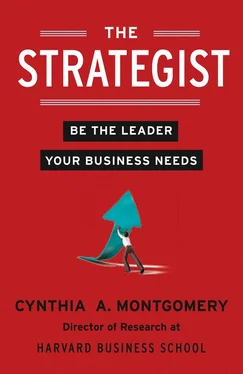The story you will write as a strategist will be set against the backdrop of your industry. It must be true to its realities, while having a difference that’s all its own. It’s to the second of these challenges that we now turn.
WE’VE LEARNED SOME painful lessons about the challenges that confront strategists in the face of unattractive industry forces. With this chapter, I begin mapping the path out of the wilderness: specifically, explaining how some astute strategists have managed to distinguish their businesses even in the face of such headwinds.
The journey starts with an individual: Ingvar Kamprad, the founder of IKEA who by all accounts built one of the world’s greatest fortunes. Like Richard Manoogian of Masco, Kamprad was in the furniture business, but his story couldn’t be more different. In 2010, his privately held company, which he started in 1943 at the age of seventeen, had sales of 23.1 billion euro, net profits of 2.5 billion euro, and gross margins of 46 percent.
And the numbers don’t even begin to capture IKEA’s powerful hold on consumers. As BusinessWeek put it, “Perhaps more than any other company in the world, IKEA has become a curator of people’s lifestyles, if not their lives. IKEA World [is] a state of mind that revolves around contemporary design, low prices, wacky promotions, and an enthusiasm that few institutions in or out of business can muster.” 1
How did Kamprad succeed where Manoogian failed? He built his company by creating what I like to call a difference that matters. (The full meaning of this phrase will become clear as the story unfolds.) He did so, not by ignoring industry forces, as Manoogian did, but by creating a company that could thrive and add value in the midst of them.
If you’re one of the millions who have shopped at IKEA, you’ll likely have indelible memories of vast, bright, modern stores designed so that entering customers follow a winding path through a huge building filled with furnishings and a great miscellany of housewares. When you chose a piece of furniture—a simple Micke desk for 69 euro, or a ten-person Norden dining table for 269 euro—you noted the information on an order slip, continued on the path to a warehouse-like room, wrestled a flat box containing the item onto your shopping trolley, carted it home on the rooftop of your car, and assembled it yourself. If you brought the kids, you may have parked them in the on-site child care center; you may also have stopped at the restaurant to sample tasty and inexpensive food ranging from salmon to Swedish meatballs and lingonberry tarts. It’s almost a theme park: probably not a customer experience you’d relish if you’ve made your fortune, but when you were starting out, there was nothing that could match it.
RURAL ROOTS
One could say that Ingvar Kamprad was a natural-born entrepreneur. “Trading was in my blood” he told his biographer, Bertil Torekull. 2Kamprad was about five when his aunt helped him buy a hundred boxes of matches from a store in Stockholm that he then sold individually at a profit in his rural hometown of Agunnaryd, deep in the farmland of Smaland. Soon he was selling all sorts of merchandise: Christmas cards, wall hangings, lingonberries (he picked them himself), fish (which he caught), and more. At eleven, he made enough money to buy a bicycle and typewriter. “From that time on,” he recounted, “selling things became something of an obsession.” 3
Before going to the School of Commerce in Gothenburg, Kamprad signed the paperwork to start his own trading firm, IKEA Agunnaryd [I for Ingvar, K for Kamprad, E for the family farm Elmtaryd, and A for Agunnaryd]. The mail-order business grew to include everything from fountain pens and picture frames to watches and jewelry. With a keen eye for value, Kamprad ferreted out the lowest-cost sources. Frugality was the norm in Smaland. Its farmers, eking their living from a harsh and spare environment, had to make every penny count.
Noticing that his toughest competitor in the catalog business sold furniture, Kamprad decided to add some to his offerings, supplied by small local furniture makers. Furniture quickly became the biggest part of his business; in the postwar boom, Swedes were buying a lot of it. In 1951, at age twenty-five, he dropped all his other products to focus exclusively on furniture.
Almost immediately he found himself in a crisis. Growing competition from other mail-order firms led to a price war. Across the industry, quality dropped as merchants and manufacturers cut costs. Complaints started to mount. “The mail order trade was risking an increasingly bad reputation,” Kamprad said. 4He didn’t want to join the race to the bottom, but how could he persuade customers that his goods were sound when they had only catalog descriptions to rely on? His answer: create a showroom where customers could see the merchandise firsthand. In 1953 he opened one in an old two-story building. The furniture was on the ground floor; upstairs were free coffee and buns. Over a thousand people came to the village for the opening, and a gratifying number wrote out orders. By 1955, IKEA was sending out a half a million catalogs and had sales of 6 million krona.
Kamprad understood his customers on a personal level. As he would later say, in explaining IKEA’s philosophy, “Since IKEA turns to the many people who as a rule have small resources, the company must be not just cheap, nor just cheaper—but very much cheaper … the goods must be such that ordinary people can easily and quickly identify the lowness of the price.” 5
By following this philosophy, Kamprad became a force to contend with in the Swedish furniture industry—and, not liking his low prices, the industry struck back. Sweden’s National Association of Furniture Dealers began pressuring suppliers to boycott him and, with the support of the Stockholm Chamber of Commerce, banned him from trade fairs. Many of the suppliers stopped selling to him, and those that continued to do business with IKEA resorted to cloak-and-dagger maneuvers: sending goods to fictitious addresses, delivering in unmarked vans, and changing the design of products sold to IKEA so they wouldn’t be recognized. Soon Kamprad was suffering the humiliation of not being able to deliver on orders.
He counterattacked on several fronts—for example, he began paying suppliers within ten days, as opposed to the standard industry practice of three or four months, and he started a flock of little companies to act as intermediaries. These moves helped, but IKEA was growing rapidly and supplies were short. Without a reliable source of supply, Kamprad feared his business would be doomed.
Having heard that Poland’s communist government was hungry for economic development, Kamprad began scouring the Polish countryside. He found many eager and willing small manufacturers laboring in the shadow of the bureaucracy. Their plants were antiquated and the quality of their products was dreadful, so Kamprad located better-quality (though used) machinery in Sweden. He and his staff moved the machinery to Poland and installed it, working hand in hand with the manufacturers to raise productivity and quality. The furniture they turned out ended up costing about half as much as Swedish-made equivalents and Kamprad was able to nail down his costs on a huge new scale.
Thus the boycott turned out to be what I call an “inciting incident,” to borrow a phrase from screenwriter Robert McKee—an event that propelled a critical strategic shift. 6“New problems created a dizzying chance,” Kamprad said. “When we were not allowed to buy the same furniture others were, we were forced to design our own, and that came to provide us with a style of our own, a design of our own. And from the necessity to secure our own deliveries, a chance arose that in its turn opened up a whole new world to us.” 7
Читать дальше








![Theresa Cheung - The Dream Dictionary from A to Z [Revised edition] - The Ultimate A–Z to Interpret the Secrets of Your Dreams](/books/692092/theresa-cheung-the-dream-dictionary-from-a-to-z-r-thumb.webp)



